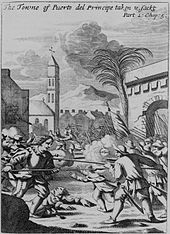Attacks on Puerto Principe and Portobello (1667–1668)
In 1667 diplomatic relations between the kingdoms of England and Spain were worsening, and rumours began to circulate in Jamaica about a possible Spanish invasion. Modyford authorised privateers to take action against the Spanish, and issued a letter of marque to Morgan "to draw together the English privateers and take prisoners of the Spanish nation, whereby he might inform of the intention of that enemy to attack Jamaica, of which I have frequent and strong advice".[24] He was given the rank of admiral and, in January 1668, assembled 10 ships and 500 men for the task; he was subsequently joined by 2 more ships and 200 men from Tortuga (now part of Haiti).[22][25]
Morgan's letter of marque gave him permission to attack Spanish ships at sea; there was no permission for attacks on land. Any plunder obtained from the attacks would be split between the government and the owners of the ships rented by the privateers. If the privateers stepped outside their official remit and raided a city, any resultant plunder would be retained by the privateers. Rogoziński observes that "attacks on cities were illegal piracy—but extremely profitable",[22] although Zahedieh records that if Morgan was able to provide evidence of a potential Spanish attack, the attacks on cities were justifiable under the terms of his commission.[2] Morgan's initial plan was to attack Havana, but, on discovering it was heavily defended, this was changed to Puerto Principe (now Camagüey), a town 50 miles (80 km) inland. Morgan and his men took the town, but the treasure obtained was less than hoped for.[26][27] According to Alexandre Exquemelin, who sailed with Morgan, "It caused a general resentment and grief, to see such a small booty".[28] When Morgan reported the taking of Puerto Principe to Modyford, he informed the governor that they had evidence that the Spanish were planning an attack on British territory: "we found seventy men had been pressed to go against Jamaica ... and considerable forces were expected from Vera Cruz and Campeachy ... and from Porto Bello and Cartagena to rendezvous at St Jago of Cuba [Santiago]".[29]
After the action, one of the English privateers quarrelled with one of his French shipmates and stabbed him in the back, killing him. Before a riot between the French and English sailors could begin, Morgan arrested the English sailor, and promised the French sailors that the man would be hanged on his return to Port Royal. Morgan kept his word and the sailor was hanged.[30] After dividing the spoils of the conquest of Puerto Principe, Morgan announced a plan to attack Porto Bello (now in modern-day Panama). The city was the third largest and strongest on the Spanish Main, and on one of the main routes of trade between the Spanish territories and Spain. Because of the value of the goods passing through its port, Porto Bello was protected by two castles in the harbour and another in the town.[31] The 200 French privateers, unhappy with the division of the treasure and the murder of their countryman, left Morgan's service and returned to Tortuga.[32] Morgan and his ships briefly landed at Port Royal before leaving for Porto Bello.[31]
On 11 July 1668 Morgan anchored short of Porto Bello and transferred his men to 23 canoes, which they paddled to within three miles (4.8 km) of the target. They landed and approached the first castle from the landward side, where they arrived half an hour before dawn. They took the three castles and the town quickly.[33][34] The privateers lost 18 men, with a further 32 wounded; Zahedieh considers the action at Porto Bello displayed a "clever cunning and expert timing which marked ... [Morgan's] brilliance as a military commander".[2]
Exquemelin wrote that in order to take the third castle, Morgan ordered the construction of ladders wide enough for three men to climb abreast; when they were completed he "commanded all the religious men and women whom he had taken prisoners to fix them against the walls of the castle ... these were forced, at the head of the companies to raise and apply them to the walls ... Thus many of the religious men and nuns were killed".[35] Terry Breverton, in his biography of Morgan, writes that when a translation of Exquemelin's book was published in England, Morgan sued for libel and won. The passage about the use of nuns and monks as a human shield was retracted from subsequent publications in England.[36]
Morgan and his men remained in Porto Bello for a month. He wrote to Don Agustín, the acting president of Panama, to demand a ransom for the city of 350,000 pesos.[n 9] As they stripped the city of its wealth it is probable that torture was used on the residents to uncover hidden caches of money and jewels. Zahedieh records that there were no first-hand reports from witnesses that confirmed Exquemelin's claim of widespread rape and debauchery.[2] After an attempt by Don Agustín to recapture the city by force – his army of 800 soldiers was repelled by the privateers – he negotiated a ransom of 100,000 pesos.[38] Following the ransom and the plunder of the city, Morgan returned to Port Royal, with between £70,000 and £100,000 of money and valuables; Zahedieh reports that the figures were more than the agricultural output of Jamaica, and nearly half Barbados's sugar exports. Each privateer received £120 – equivalent to five or six times the average annual earnings of a sailor of the time.[2] Morgan received a five per cent share for his work;[39] Modyford received a ten per cent share, which was the price of Morgan's letter of marque.[40][41] As Morgan had overstepped the limits of his commission, Modyford reported back to London that he had "reproved" him for his actions although, Zahedieh observes, in Britain "Morgan was widely viewed as a national hero and neither he nor Modyford were rebuked for their actions".[2]





No comments:
Post a Comment